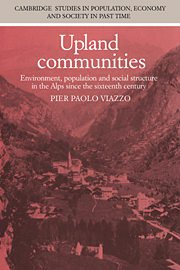 Upland Communities
Upland Communities Book contents
- Frontmatter
- Contents
- List of illustrations
- List of tables
- List of abbreviations
- Acknowledgements
- Introduction: anthropology, historical demography and the study of mountain societies
- 1 Environment, population and social structure: the Alpine village as an ecosystem
- 2 Open systems, open questions
- 3 Anthropologists in the Alps
- 4 The changing demography of Alpine communities
- 5 The traditional economy and its demise
- 6 The causes and consequences of Alpine emigration
- 7 The wealth from the earth: mining and immigration
- 8 Population, resources and homeostatic regulation
- 9 The domestic domain
- 10 Upland communities
- A summary of conclusions
- Bibliography
- Index
7 - The wealth from the earth: mining and immigration
Published online by Cambridge University Press: 13 October 2009
- Frontmatter
- Contents
- List of illustrations
- List of tables
- List of abbreviations
- Acknowledgements
- Introduction: anthropology, historical demography and the study of mountain societies
- 1 Environment, population and social structure: the Alpine village as an ecosystem
- 2 Open systems, open questions
- 3 Anthropologists in the Alps
- 4 The changing demography of Alpine communities
- 5 The traditional economy and its demise
- 6 The causes and consequences of Alpine emigration
- 7 The wealth from the earth: mining and immigration
- 8 Population, resources and homeostatic regulation
- 9 The domestic domain
- 10 Upland communities
- A summary of conclusions
- Bibliography
- Index
Summary
Industrial employment and geographical mobility in the ‘age of autarky’
Although the causes and nature of Alpine emigration have often been misunderstood, as the preceding chapter has tried to demonstrate, its significance has hardly been questioned by any scholar. It is indeed a commonplace among students of the Alpine world that seasonal emigration was the best way of optimizing labour during the slack winter months, while permanent emigration provided a crucial safety valve in a marginal environment where limited resources tended to be rapidly outstripped by demographic growth. In the cybernetic jargon favoured by ecological anthropologists, emigration was one of the ‘servomechanisms’ whereby a viable balance between population and resources could be achieved or restored. And in Malthus's model, too, emigration was granted a major role as one of the variables which could fundamentally affect the economic and demographic structure of upland communities and turn them into ‘open’ systems.
By contrast, the importance of immigration has been usually played down. It is of course acknowledged that the boundaries of Alpine communities were regularly crossed by a trickle of in-marrying spouses (mainly wives) from neighbouring villages. But, as far as proper migratory movements are concerned, the more or less tacit assumption is that, after the end of the medieval colonization of the high valleys, people from the lowlands had clearly little incentive to try and settle in the snow-bound and increasingly overpopulated uplands.
- Type
- Chapter
- Information
- Upland CommunitiesEnvironment, Population and Social Structure in the Alps since the Sixteenth Century, pp. 153 - 177Publisher: Cambridge University PressPrint publication year: 1989
